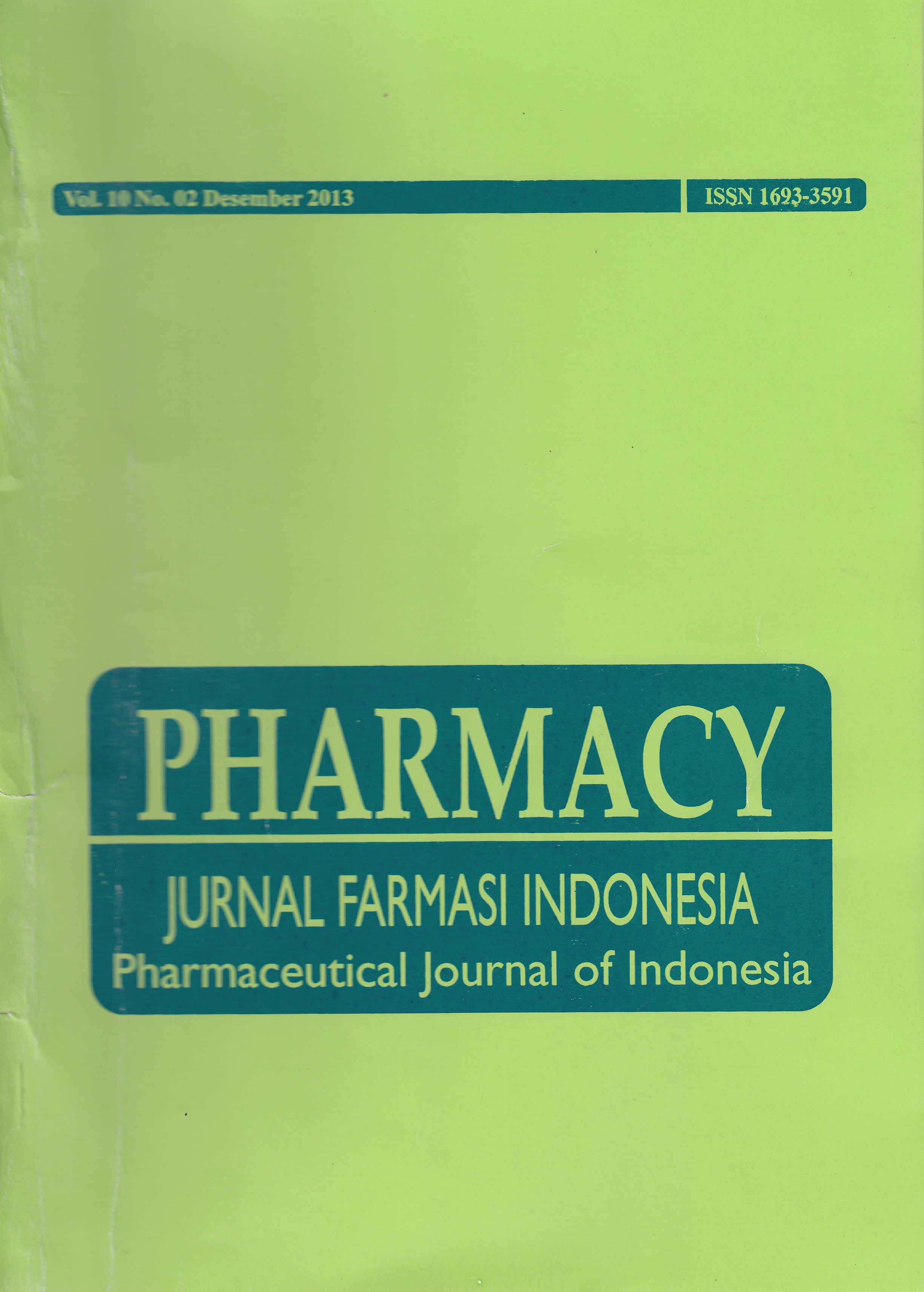PERBANDINGAN MODEL DAN PROFIL PELEPASAN OBAT SUKAR LARUT DARI MATRIKS BERBASIS NATURAL-GUM PADA SEDIAAN TABLET LEPAS LAMBAT
DOI:
https://doi.org/10.30595/pji.v10i2.798Abstract
ABSTRAK Berbagai polimer alam telah digunakan sebagai kontrol pelepasan obat dalam sediaan lepas lambat. Karagenan, pektin, dan glukomanan berpotensi sebagai matriks untuk mengontrol pelepasan obat. Penelitian ini bertujuan untuk mengetahui dan membandingkan pola dan metode pelepasan obat dati matriks berbasis natural-gum (karagenan, pektin dan glukomanan) dengan berbagai model kinetika pelepasan obat pada tablet lepas lambat teofilin. Teofilin digunakan sebagai model obat dan tablet dibuat dengan metode granulasi basah. Matriks yang digunakan adalah pektin, karagenan, dan glukomanan dengan konsentrasi 20%, 30%, dan 40%. Pemeriksaan mutu fisik dilakukan pada granul dan tablet. Pelepasan obat dilakukan dengan alat tipe II USP dengan putaran 75 rpm, medium dapar fosfat pH 4,5 selama 6 jam. Hasil dibandingkan secara statistic dengan ANOVA taraf kepercayaan 95%, model dependent dan model independent. Hasil menunjukkan bahwa peningkatan konsentrasi matriks glukomanan dan pektin menurunkan waktu alir dan peningkatan konsentrasi matriks menurunkan kompaktibilitas. Matriks pektin dan karagenan menunjukkan pelepasan konstan. Kinetika pelepasan yang paling dominan mengikuti kinetika orde nol dengan koefisien determinasi paling tinggi dan perbedaan antara data yang teramati dan data prediksi yang rendah (AICc dan RMSE) dan mekanisme pelepasan dikontrol oleh erosi pada matriks. Kata kunci: pektin, karagenan, glukomanan, pelepasan obat ABSTRACT Various natural polymers had been used as a control drug release in sustained release dosage form. Carrageenan, pectin, and glucomannan were potential as a matrix to control the release of drugs. This study is aimed at determining and comparing the patterns and methods of drug release from matrix natural-gum based (carrageenan, pectin, and glucomannan) with different models of drug release kinetics in sustained release theophylline tablets. Theophylline was used as a drug model and tablets which was made by wet granulation method. The matrix used is pectin, carrageenan, and glucomannan with the concentration 20%, 30%, and 40%. Physical quality inspection was conducted on granules and tablets. Drug release was carried out with apparatus type II USP at 75 rpm rotation, medium phosphate buffer pH 4,5 for 6 hours. The results were statistically compared by ANOVA level of 95%, dependent model and independent model. The results showed that the increasing concentration of glucomannan and pectin matrix decreased the flow time and increased concentrations of matrix lowers compatibility. Matrix of pectin and carrageenan showed a constant release. The most dominant release kinetics followed zero order kinetics with the highest determination coefficient and the difference between the observed data and the data predicted low (AICC and RMSE) and the release mechanism was controlled by the erosion of the matrix. Key words: pectin, carrageenan, glucomannan, drug releaseReferences
Depkes RI, 1995, Farmakope Indonesia edisi IV. Jakarta: Departemen Kesehatan Republik Indonesia. Hal 999-1002.
Colombo, I., Lapasin, R., Grassi, G., Grassi, M., 2007. Understanding drug release and absorption mecanisms: a physical and mathematical approach New York: CRC Press Taylor & Francis Group. Hal 388-411.
Paulo, C dan Lobo, J.M.S., 2001. Review: modeling and comparison of dissolution profile, Eur.J. Pharm. Sci., 13 : 123-133.
Fudholi, A., 1983. Metodologi formulasi dalam kompresi direk. Medika, 7(9):586 – 593.
Jana, S., Gandhi, A., Sen K.K., Basu, S.K., 2011. Natural polymer and their application in drug delivery and biomedical field. J. Pharm. Sci. Tech. 1(1):16-27.
Mendyk, A., Jachowicz, R., Fijorek, K., Doro, P., Kulinowski, P., Polak, S., 2012. KinetDS: an open source software for dissolution test daya analysis. Dissolution Technology, 19(1):6-11
Motulsky, H.J., Christopoulos, A., 2003. Fitting model to biological data using linear and nonlinear regression: a practical guide to curve fitting. San Diego: GraphPad. Hal 53-54,134-143.
Nokhodchi, A., Raja S., Patel P., Asare-Addo K., 2012. The role of oral controlled release matrix tablets in drug delivery system. BioImpacts. 2(4):175-187.
Singh, K.K., 2009. Carragenan. In Rowe R.C., Sheskey, P.J., Quinn, M.E. (Ed). Handbooks of pharmaceutical exipients. London: Pharmaceutical Press. Hal 122.
Shah, S.N.H.S., Asghar, S., Choudhry, M.A., Akash, M.S.H., Rehman, N., Baksh, S., 2009. Formulation and evaluation of natural gum-based sustained release matrix tablet of flurbiprofen using respone surface methodology. Drug. Dev. and Ind. Pharm. 35(12):1470-1478.
Sungthongjeen, S., Srimornsak, P., Pitaksuteepong, T., Somsiri, A., 2004. Effect of degree of esterification of pectin and calcium amount on drug release from pectin-based matrix tablets. AAPS Pharm. Sci. Tech. 5(1):1-8.
Yuksel, N., Kanik, A.E., Baykara, T., 2000. Comparison of in vitro dissolution profiles by ANOVA-based, model-dependent and independent methods. Int. J. Pharm. 209:57-67.
Downloads
Published
How to Cite
Issue
Section
License
Authors who publish with this journal agree to the following terms:
- Authors retain copyright and grant the journal right of first publication with the work simultaneously licensed under a Creative Commons Attribution 4.0 International License that allows others to share the work with an acknowledgement of the work's authorship and initial publication in this journal.
- Authors are able to enter into separate, additional contractual arrangements for the non-exclusive distribution of the journal's published version of the work (e.g., post it to an institutional repository or publish it in a book), with an acknowledgement of its initial publication in this journal.
- Authors are permitted and encouraged to post their work online (e.g., in institutional repositories or on their website) prior to and during the submission process, as it can lead to productive exchanges, as well as earlier and greater citation of published work (See The Effect of Open Access).






